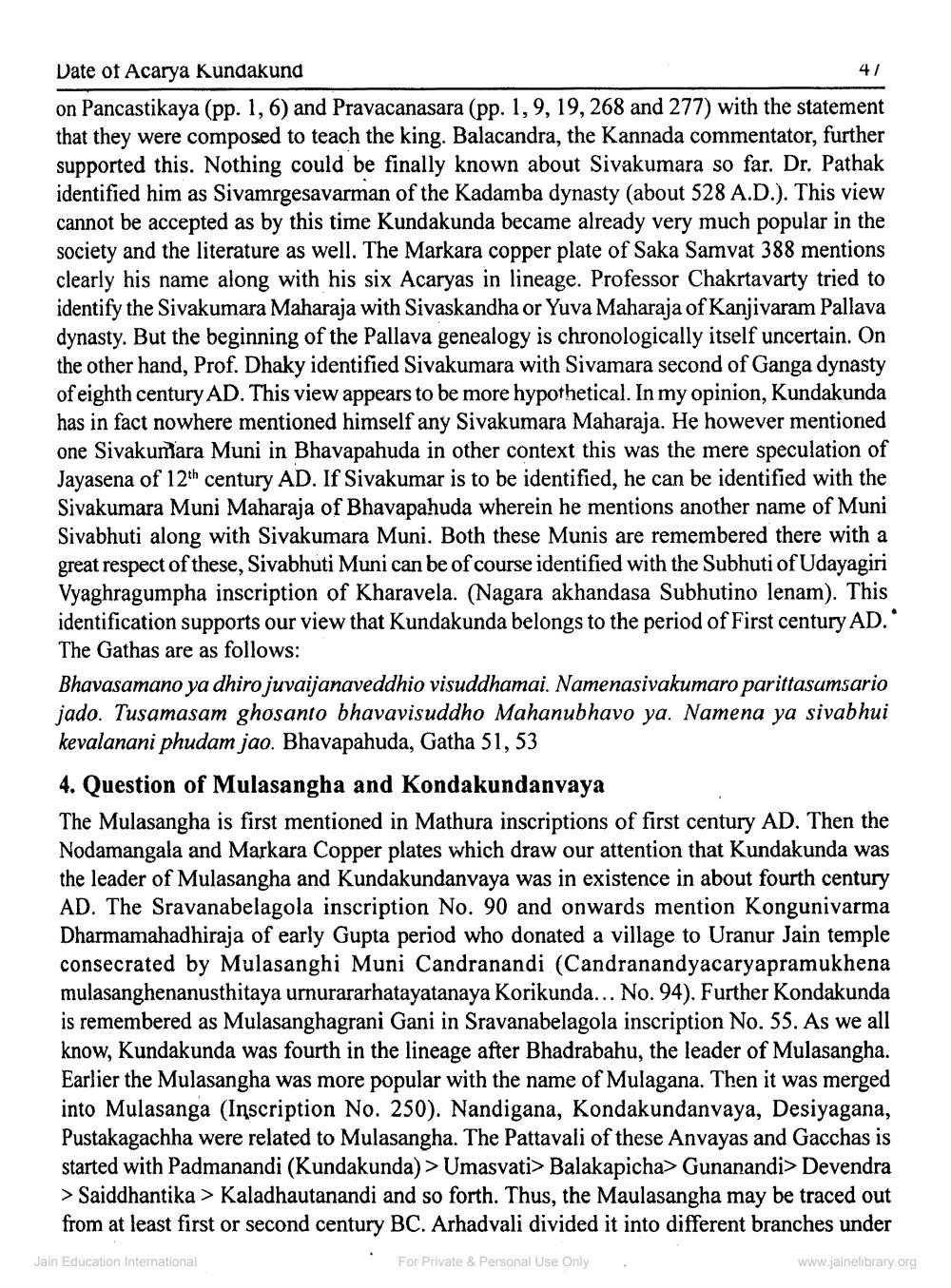________________
Date of Acarya Kundakund
4/ on Pancastikaya (pp. 1, 6) and Pravacanasara (pp. 1,9,19,268 and 277) with the statement that they were composed to teach the king. Balacandra, the Kannada commentator, further supported this. Nothing could be finally known about Sivakumara so far. Dr. Pathak identified him as Sivamrgesavarman of the Kadamba dynasty (about 528 A.D.). This view cannot be accepted as by this time Kundakunda became already very much popular in the society and the literature as well. The Markara copper plate of Saka Samvat 388 mentions clearly his name along with his six Acaryas in lineage. Professor Chakrtavarty tried to identify the Sivakumara Maharaja with Sivaskandha or Yuva Maharaja of Kanjivaram Pallava dynasty. But the beginning of the Pallava genealogy is chronologically itself uncertain. On the other hand, Prof. Dhaky identified Sivakumara with Sivamara second of Ganga dynasty of eighth century AD. This view appears to be more hypothetical. In my opinion, Kundakunda has in fact nowhere mentioned himself any Sivakumara Maharaja. He however mentioned one Sivakumara Muni in Bhavapahuda in other context this was the mere speculation of Jayasena of 12th century AD. If Sivakumar is to be identified, he can be identified with the Sivakumara Muni Maharaja of Bhavapahuda wherein he mentions another name of Muni Sivabhuti along with Sivakumara Muni. Both these Munis are remembered there with a great respect of these, Sivabhuti Muni can be of course identified with the Subhuti of Udayagiri Vyaghragumpha inscription of Kharavela. (Nagara akhandasa Subhutino lenam). This identification supports our view that Kundakunda belongs to the period of First century AD.* The Gathas are as follows: Bhavasamano ya dhiro juvaijanaveddhio visuddhamai. Namenasivakumaro parittasumsario jado. Tusamasam ghosanto bhavavisuddho Mahanubhavo ya. Namena ya sivabhui kevalanani phudam jao. Bhavapahuda, Gatha 51, 53
4. Question of Mulasangha and Kondakundanvaya The Mulasangha is first mentioned in Mathura inscriptions of first century AD. Then the Nodamangala and Markara Copper plates which draw our attention that Kundakunda was the leader of Mulasangha and Kundakundanvaya was in existence in about fourth century AD. The Sravanabelagola inscription No. 90 and onwards mention Kongunivarma Dharmamahadhiraja of early Gupta period who donated a village to Uranur Jain temple consecrated by Mulasanghi Muni Candranandi (Candranandyacaryapramukhena mulasanghenanusthitaya urnurararhatayatanaya Korikunda... No. 94). Further Kondakunda is remembered as Mulasanghagrani Gani in Sravanabelagola inscription No. 55. As we all know, Kundakunda was fourth in the lineage after Bhadrabahu, the leader of Mulasangha. Earlier the Mulasangha was more popular with the name of Mulagana. Then it was merged into Mulasanga (Inscription No. 250). Nandigana, Kondakundanvaya, Desiyagana, Pustakagachha were related to Mulasangha. The Pattavali of these Anvayas and Gacchas is started with Padmanandi (Kundakunda) > Umasvati>Balakapicha> Gunanandi> Devendra > Saiddhantika > Kaladhautanandi and so forth. Thus, the Maulasangha may be traced out from at least first or second century BC. Arhadvali divided it into different branches under
Jain Education International
For Private & Personal Use Only
www.jainelibrary.org




